|
Minolta was one of the most successful SLR manufacturers throughout the 1960s. With their SR and SRT series of cameras and Rokkor lenses they were consistently among the top 2 in SLR sales by the Big 4. (Pentax was the other market leader. Canon and Nikon were the two junior members as far as sales went.) They had sold more than 400,000 SLRs per year from 1966 through 1970. Nevertheless, they (as did the other members of the Big 4) realized that the market for fully-mechanical, manual-exposure SLRs was starting to reach a saturation point. And competition between the Japanese companies was heating up now that they had collectively pushed the German camera makers into irrelevance in the SLR market. Electronically-controlled SLRs would be the new weapons in the battle for market supremacy during the 1970s. The Big 4 had all begun development of these in the mid-'60s and now the fruitage of that labour began to appear: the Pentax Electro Spotmatic & ES (1971); the Nikkormat EL (1972); and the Canon EF (1973). Although Minolta would be the last to introduce their challenger in 1974, the XE-7 (XE-1 in Europe & XE in Japan) would turn out to be the best-seller among these first-generation electronic SLRs. Minolta "X" Origins The roots of the XE can be traced back to the mid-1960s and Minolta's efforts to develop a pro-level SLR to compete with the Nikon F. In the early '60s Minolta had been very successful with its SR series of amateur SLRs and was the overall sales leader. However, Nikon had a virtual monopoly in the pro market. Minolta wanted to get in on some of that action and the XK (XM in Europe & X1 in Japan) of 1973 was the result. The XK bore an uncanny resemblance to the Nikon F & F2 ;-). Once you got past that however, Minolta's tradition of innovation started to peek through. The XK featured an electronic shutter with aperture-priority autoexposure, as the first, and only professional SLR until 1975 (with the debut of the Contax RTS), to do so. It was a failure in the sales department, but it did serve as the catalyst of Minolta SLR development during the 1970s. The XK's DNA would trickle down into the amateur SLR lineup. And that brings us to the XE. Minolta and Canon initially took a similar approach in their attempts to compete with Nikon at the the top end of the market. They both introduced pro models (with interchangeable finders and focusing screens) and then each brought out a high-end amateur body with much of the same technology in a fixed-prism design. This mirrored Nikon's platform of the F-series cameras with the Nikkormats slotting below (in manual FTn and electronic EL forms). So the XE took its place as the top amateur Minolta body available in 1974. Notably, another factor came in to play in the XE's conception. In June of 1972, Minolta entered into an agreement with Leitz to share technology and cooperate in R&D. This demonstrated how dominant the Japanese manufacturers had become in the camera world and their expertise in electronics was now prized by the German companies. And Minolta was happy to avail themselves of Leitz' experience in optics and production techniques. The XE was the first SLR model developed under this cooperative arrangement and became the template for the Leica R3, as the future XD would also serve as the basis of the R4, R5, R6, and R7 models. 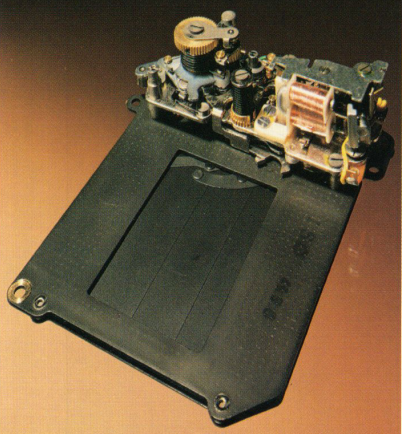 The Copal-Leitz Shutter The Copal-Leitz Shutter The Exceptional XE The XE wasn't just all about the XK's hand-me-downs. It had some distinct features of its own. The most notable is the shutter. The XK used a titanium horizontal-travel shutter in the style of the Nikon F. The XE would be the first Minolta with a metal-bladed vertical-travel shutter (a la the Nikkormat EL). Copal was and continues to be a leading supplier of shutters to the camera companies. They often collaborate with the manufacturers to design and produce a shutter that will meet the performance and reliability needs of a particular model. The first Japanese mechanical vertical-travel focal-plane shutter for an SLR was introduced by Konica in 1960 and it evolved with help from Mamiya and Copal into the Copal Square I. To start with, only Konica, Pentax, and Mamiya had access to this shutter. Because Nikon sub-contracted the production of its amateur level Nikkorex F to Mamiya, they were able to use the Square I shutter beginning in 1962. In 1965, the Copal Square S was introduced and Nikon could now use it in their new Nikkormat cameras. Electronic versions of the Square S were used in the Nikkormat EL and the Canon EF (the EF using a hybrid system with mechanical speeds from 1/1000 - 1/2 sec. and electronic control from 1 to 30 sec.). Because of its vertical orientation, the Square S offered a higher flash-sync speed than horizontal-travel shutters. The biggest issue with the metal-bladed Square S was that it was noisier than traditional cloth shutters. In the case of the XE, Leitz did the primary design and collaborated with Copal to produce a quieter shutter. You can definitely hear the difference! Leitz has also long been very conscious about the responsiveness of a camera. Their rangefinders were justly famed for their minimal shutter lag (around 16 milliseconds for an M3). An SLR has a major handicap in this regard: time has to be allowed for raising the mirror out of the way before exposure. With the XE, Minolta and Leitz were able reduce shutter lag to 38ms, making it one of the most responsive SLRs of its era and as fast as the modern-day Nikon F6. The XE is the only Minolta SLR to feature the gorgeous Copal-Leitz shutter. Speeds are from 1/1000 to 4 sec., with a mechanical back-up of 1/90 sec. which is also the flash-sync speed. 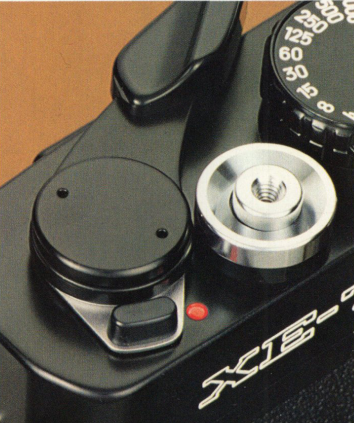 Film Advance & ME Levers Film Advance & ME Levers The XE features a superior multiple exposure function to the XK. The XK requires the user to push in the film rewind release button on the bottom of the camera before winding the film advance lever to re-cock the shutter for the next exposure. On the XE, you simply push a lever concentric to the film advance lever with your index finger which exposes a red dot and then wind the advance lever. It's quicker, more convenient, and the exposure counter does not advance as it does on the XK. The XE also uses the standard ISO flash hot-shoe as opposed to the XK's blatant adoption of Nikon's inconvenient over-the-rewind-knob contraption. But what makes the XE exceptional is not its features so much as the integration of all its controls and mechanisms. In other words, how it feels. The XE feels like it has been machined from a single billet of brass. Controls move precisely and positively, yet oh so smoothly! It has one of the finest film advance mechanisms of any vintage SLR. People rave about the smoothness of the Nikon F3's advance with all of its ball bearings, and it is definitely one of the best. But an XE feels like silk on silk, its Leitz heritage shining through. Cost-cutting was only a couple of years away, so the XE makes a strong argument as the pinnacle of material and build quality among Minolta manual focus SLRs. And it certainly holds its own against any other contemporary SLR. It's the epitome of "brass & glass", especially when paired with an MC Rokkor lens. If holding one in your hands doesn't make you want to go take pictures, check for a pulse ;-). The XE was a hit for Minolta, so much so that they brought out a slightly de-contented version, the XE-5 (XE-b in Japan) in 1975. The XE-5 lacks the eyepiece shutter, the viewfinder aperture & shutter speed displays, the film safe-load signal, and the multiple exposure capability (strangely, the XE-b retained multiple exposure) of the XE-7. And it came only in chrome, whereas the the XE-7 was only available in black. (The XE and XE-1 came almost exclusively in chrome, but there are a few black units out there.) But all of the important stuff was still there: the Copal-Leitz shutter, that buttery film advance, reliable CLC (Contrast Light Compensator) metering, DOF preview, self-timer, and exposure compensation. Minolta sold 600,000 XEs (all versions) in 4 years (1974-77), outpacing Pentax (ES/ESII & K2: 380,000 from 1971-80), and Canon (EF: 320,000 from 1973-78). And although Nikon produced 760,000 EL/ELW/EL2 cameras from 1972-80, during the time the XE was on the market it outsold the Nikkormats/Nikons by 130,000 units. Not bad for being the late starter! Is the XE for You? Let's consider some pros and cons of XE ownership compared to its competitors. We are comparing it with models that were its direct rivals in size & weight, general features, and era. The Canon EF, Nikkormat EL, and Pentax K2 are generally more expensive than the XE in today's market, but the Pentax ES/ESII can be had for less than an XE. Which is best for you depends on your priorities. Hopefully, this comparison will be of some help. Canon EF:
Nikkormat EL:
Pentax Electro Spotmatic/ES/ESII/K2:
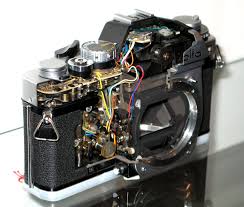 Cutaway View of XE-1 Cutaway View of XE-1 Conclusion The Minolta XE is a true classic. It is a marvelous example of the precision craftsmanship that was increasingly under siege by the bean counters in the late 1970s. With the introduction of the Canon AE-1 in 1976, the race to the bottom (in terms of volume sales of cheaper SLRs to the mass consumer market) had begun. Pick up any Minolta XG or X-xxx body and you will immediately detect the magnitude of the change. While they are quite capable of the same imaging performance, the feel just isn't there. An XE offers an immersive photographic experience, that ineffable feeling of using a finely honed tool to create something. You cannot help but smile when one is in your hands. Next time: Isn't "D" Supposed to Come Before "E"? References: Minolta @ Camera-wiki.org Project SLR production numbers @ knippsen.blogspot.ca Minolta XK, XE-7 & XE-5 Instruction Manuals @ www.butkus.org Minolta XK/XM/X-1 @ http://www.rokkorfiles.com/XK.html A Short History of the Konica SLR @ http://www.konica-collector.org/history Part 3: Nikkorex F @ http://imaging.nikon.com/history/chronicle Shutter lag @ https://en.wikipedia.org/wiki/Shutter_lag Nikkormat/Nikon Instruction Manuals @ www.butkus.org Canon EF Instruction Manual @ www.butkus.org Pentax Instruction Manuals @ www.butkus.org Picture credits: Minolta XM @ de.wikipedia.org; XE-1 @ en.wikipedia.org
6 Comments
12/24/2019 06:02:35 pm
I have a love for older cameras-that's where I started years ago. I love and use a Konica IIIA, and now just bought a XE-1 with a 50mm f1.4 on it for 25 bucks. Going to send both off for some dustin & cleanin.. looking forward to using it. I also have a nice stable of SR mount glass. Yippee..
Reply
C.J. Odenbach
12/26/2019 07:54:43 am
Nice score on the XE-1 with a 50/1.4, Randy! That’s a steal for the lens, let alone the body. Your SR fleet will not be disappointed ;-). Enjoy and thanks for sharing.
Reply
Howie Dewing
12/12/2020 12:57:45 pm
Can't get enough of these articles on vintage Minolta gear. My introduction to Minolta started in 1977 with an SR-T 201, my first SLR and a what a magnificent mass of metal it was An XG M replaced the stolen 201, an absolute joy to use but was its plasticky antithesis. Recently the film itch from my youth returned and I purchased a near-mint XD 11 and a less-than-mint Japanese-market XE that has a couple of issues I was hoping you could address for me. Wide open, the XE's light meter seems to function well enough for the most part, matching the XD (which itself is spot on with my digital Sony a77 II), but the meter coupling ring around the lens mount doesn't make the needle budge, thus preventing a corresponding change in shutter speeds. I can manually stop the lens down to indicate the approximate shutter speed but this seems so unnecessary. Moving the exposure and ASA adjustment dials will move the meter, so I suspect there's some sort of disconnection between the MC ring and the light meter. Have you ever encountered this, and is there any help for my XE? Also, the battery check lever barely moves and the light does not come on. I bought the XE from ebay and I really don't want to send this thing back. Any help you can give this old Minoltaphile will me greatly appreciated.
Reply
C.J. Odenbach
12/12/2020 01:54:02 pm
Thanks for reaching out, Howie. It sounds like your XE’s diaphragm pulley string has possibly become disconnected. If this has taken place on the MC ring, you can access it by removing the front flange of the bayonet mount. You will need a #0 JIS crosspoint screwdriver to do this. A Wiha #0 precision Phillips screwdriver will also work. Take pictures as you remove each piece to remind you of their configuration. There should be a slot in the side of the ring where the string slips into. There should be a knot in the end of the string to prevent it from pulling through the slot. This can become disengaged. You have to be careful upon reassembly not to pinch the string with the ring. If it has disconnected at the other end, you will need to access underneath the top plate on the rewind side of the camera. You will need a small spanning wrench to remove the nut that secures the ISO dial. There are a couple of illustrations in the Service manual on page 15 of the Explanation of Systems section and page 30 of the Disassembly, Assembly, and Adjustment Section of the MC ring connection. A free PDF of the XE Service Manual is available at www.learncamerarepair.com.
Reply
Howie Dewing
2/5/2021 10:32:44 am
Hello again. I went ahead and had my Minolta XE sent off to Garry's Camera Repair in Illinois for repair and CLA instead of attempting it myself. This grand old camera deserves a lot better than some ham-fisted klutz like me possibly ruining it forever. Besides, it only cost me $58 for them to fix everything and bring it back to its magnificence. Thanks again for your advice and for all of your not so random thoughts on vintage cameras and photography.
C.J. Odenbach
2/5/2021 12:39:05 pm
Nice to hear from you, Howie. That's great news about your XE. Happy shooting and thanks for the update.
Reply
Your comment will be posted after it is approved.
Leave a Reply. |
C.J. OdenbachSuffers from a quarter-century and counting film and manual focus SLR addiction. Has recently expanded into 1980's AF point and shoots, and (gack!) '90s SLRs. He even mixes in some digital. Definitely a sick man. Categories
All
Archives
June 2024
|
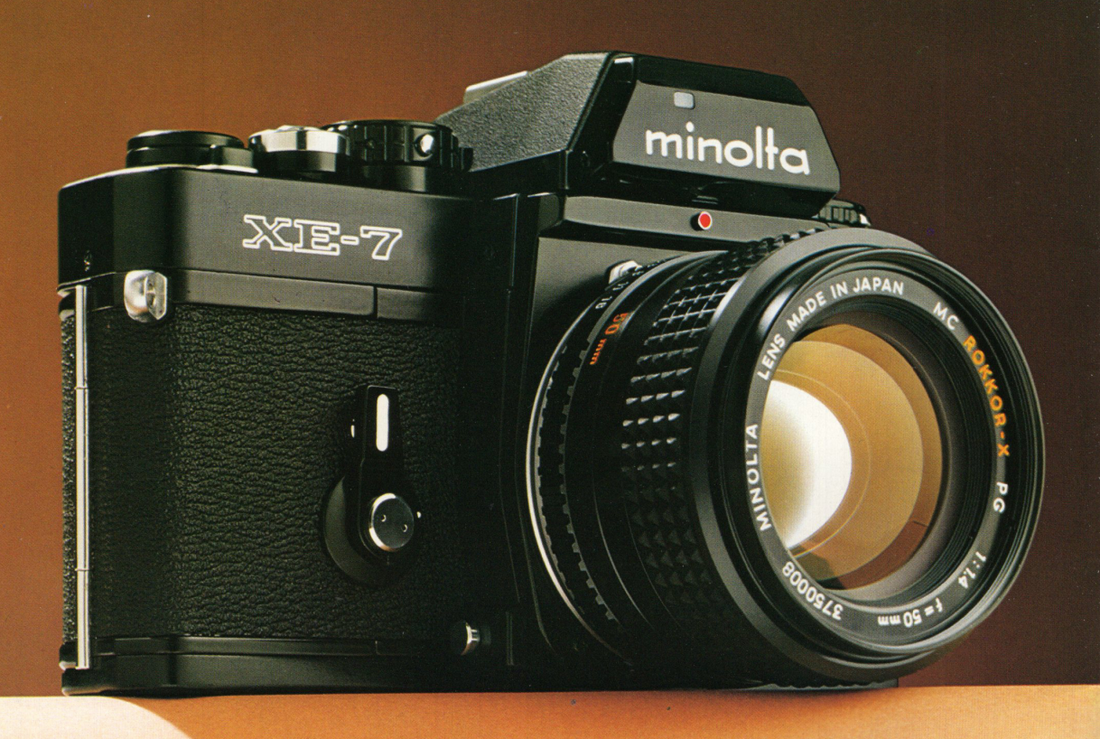
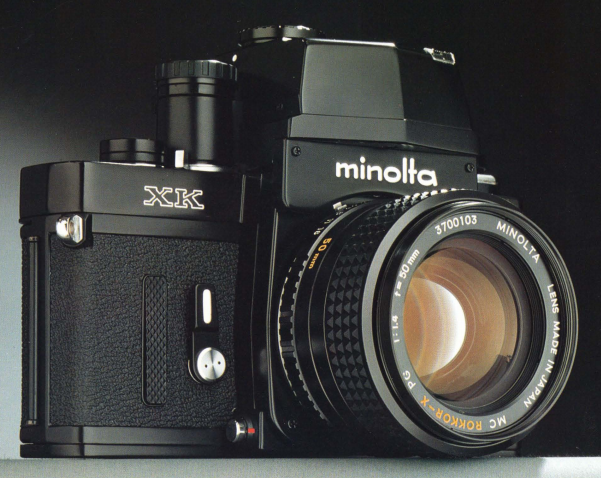
 RSS Feed
RSS Feed